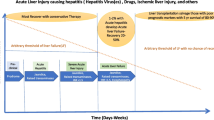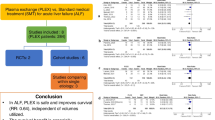Abstract
This paper reports the clinical syndrome of fulminant hepatic failure (FHF) following liver transplantation. FHF was defined as the sudden onset of liver failure [encephalopathy and prolonged International Normalised Ratio (INR)] without arterial thrombosis in the setting of a liver allograft. FHf post-transplant was seen in 8/154 (5.2%) adult patients undergoing transplantation. These eight patients developed a clinical syndrome characterised by: (a) a rapid rise in ALT levels to above 1000 U/l (mean maximum 1600 U/l), (b) a sudden increase in the INR to above 5 (mean maximum 5.6), (c) the development of high fever, (d) the persistence of thrombocytopenia (mean nadir 40×109/dl), (e) a progressive rise in the bilirubin (mean maximum 400 μmol/l) and (f) the development of hepatic encephalopathy. In seven cases this syndrome occurred following good initial graft function at day 6 post (mean)-transplant. In one case the above syndrome developed immediately after liver transplantation. Four of the eight patients developed multiorgan failure associated with systemic acidosis (mean pH 6.84). All of these patients died (mean day 11). Four patients developed systemic alkalosis. Two of these four patients underwent successful retransplantation (on days 12 and 13) and remain alive at a mean of 11 months post-transplant. Six of the eight patients received OKT3 therapy without any apparent affect on clinical outcome. Compared to a control group of patients (n=28), 2/8 versus 2/28 had a positive crossmatch with donor lymphocytes (P=NS), 1/8 versus 7/28 were ABO-non-identical (P=NS), 3/8 versus 10/21 had total MHC mismatches (P=NS) and 5/7 versus 6/16 had UW ischemic times above 10 h (P=NS). No patients had main hepatic artery thrombosis on angiography although four patients had evidence of intrahepatic microthrombi or arterial necrosis at autopsy. In all cases the histology showed massive haemorrhagic necrosis. Three cases had evidence of veno-occlusive lesions whilst foam cell arteriopathy was seen in two cases. Immunofluorescence was performed in three cases. In two cases there was evidence of immunoglobulin, complement and fibrin deposition in blood vessels. In conclusion, we describe an uncommon clinical syndrome occurring post liver transplant. This syndrome represents humorally mediated allograft rejection but there seems to be no relationship with tissue matching (antibody, ABO, MHC) or donor ischaemic times. If recognised earlier in the absence of multiorgan failure, urgent retransplantation seems to be the only effective therapy.
Similar content being viewed by others
References
Bird G, Friend P, Donaldson P, O'Grady J, Portmann B, Calne R, Williams R (1989) Hyperacute rejection in liver transplantation: a case report. Transplant Proc 21:3742–3744
Cerilli J, Clarke J, Doolin T, Cerilli G, Brasile L (1988) The significance of a donor specific vessel cross match in renal transplantation. Transplantation 46: 359–361
Cuervas-Mons V, Martinez AJ, Dekker A, Starzl TE, Thiel DH van (1986) Adult liver transplatation: an analysis of the early courses of death in 40 consecutive cases. Hepatology 6:495–501
Demetris AJ, Jaffe R, Tzakis A, Ramseya G, Todo S, Belle S, Esquivel C, Shapiro R, Markus B, Mroczek E, Thiel DH van, Sysyn G, Gordon R, Makowka L, Starzl T (1988) Antibody-mediated rejection of human orthotopic liver alllografts. Am J Pathol 132:489–502
Demetris AJ, Nakamura K, Yagihashi A, Iwaki Y, Takaya S, Hartman GG, Murase N, Bronsther O, Manez R, Fung JJ, Iwatsuki S and Starzl TE (1992) A clinicopathological study of human liver allograft recipients harboring preformed IgG lymphocytotoxic antibodies. Hepatology 16:671–681
Dirix LY, Polson RJ, Richardson A, Williams R (1989) Primary sepsis presenting as fulminant hepatic failure. QJM ed 271:1037–1043
Hanto DW, Snover DC, Sibley RK, Noreen HJ, Gajl-Pezalska KF, Najarian JS, Ascher NL (1987) Hyperacure rejection of a human orthotopic liver allograft in a presensitized recipient. Clin Transpl 1:304–310
Hubscher SG, Adams DH, Buckels JAC, McMaster P, Neuberger J, Elias E (1989) Massive haemorrhagic necrosis of the liver after liver transplantation. J Clin Pathol 42:360–370
Klintmalm GBG, Nery JR, Husberg BS, Gonwa TA, Tillery GW (1989) Rejection in liver transplantation. Hepatology 6:978–985
Sheil AG, McCaughan GW, Thompson JF, Dorney SFA, Stephen MS, Bookallil MJ (1992) The first five years' clinical experience of the Australian National Liver Transplantation. Unit. Med J Aust 156:9–16
Starzl TE, Demetris AJ, Thiel D van (1989) Liver transplantation. N Engl J Med 321:1014–1022
Starzl TE, Demetris AJ, Todo S, Kang Y, Tzakis A, Duquesnoy R, Makowka L, Banner B, Concepcion W, Porter KA (1989) Evidence for hyperacute rejection of human liver grafts: the case of the canary kidneys. Clin Transpl 3:37–45
Author information
Authors and Affiliations
About this article
Cite this article
McCaughan, G.W., Huynh, J.C., Feller, R. et al. Fulminant hepatic failure post liver transplantation: clinical syndromes, correlations and outcomes. Transpl Int 8, 20–26 (1995). https://doi.org/10.1007/BF00366706
Received:
Revised:
Accepted:
Issue Date:
DOI: https://doi.org/10.1007/BF00366706




